
With the addition of four states during the war and the immediate crisis leading to it, the United States flag went through many changes during the war. Below are the four official flags of the United States used during the war. Note that at the time of the Civil War, there was no standard arrangement for the stars in the union of the flag, thus many different arrangements were used.
 With the addition of
Kansas to the Union on January 29, 1861, the 34 star flag became
the official flag of the United States. However, the garrison
at Fort Sumter was still flying this 33 star flag at the time of
the bombardment in April 1861. Note the unusual arrangement of
the stars.
With the addition of
Kansas to the Union on January 29, 1861, the 34 star flag became
the official flag of the United States. However, the garrison
at Fort Sumter was still flying this 33 star flag at the time of
the bombardment in April 1861. Note the unusual arrangement of
the stars.
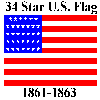 The 34 star flag was in
use through much of the first half of the war.
The 34 star flag was in
use through much of the first half of the war.
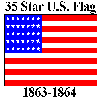 After the "secession"
of West Virginia, and its acceptance into statehood on June 19,
1863, the 35 star flag became the official flag of the United
States. This was the most commonly used U.S. flag during the
war.
After the "secession"
of West Virginia, and its acceptance into statehood on June 19,
1863, the 35 star flag became the official flag of the United
States. This was the most commonly used U.S. flag during the
war.
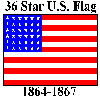 After Nevada joined the
Union on October 31, 1864, the 36 star flag became the official
flag.
After Nevada joined the
Union on October 31, 1864, the 36 star flag became the official
flag.
 Probably the first
flag of this design was the I Corps Headquarters flag used by
General John Reynolds, who was killed in action at Gettysburg.
His design was used as the basis for many of the other corps
flags.
Probably the first
flag of this design was the I Corps Headquarters flag used by
General John Reynolds, who was killed in action at Gettysburg.
His design was used as the basis for many of the other corps
flags.
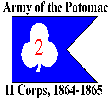 Adopted in 1864, this
flag is a modified I Corps flag with the II Corps symbol, the
trefoil or shamrock, in the center.
Adopted in 1864, this
flag is a modified I Corps flag with the II Corps symbol, the
trefoil or shamrock, in the center.
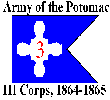 The Army of the
Potomac's III Corps used this flag which differed from the I
Corps only in the number in the symbol.
The Army of the
Potomac's III Corps used this flag which differed from the I
Corps only in the number in the symbol.
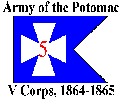 The hard-fighting V
Corps was very proud of the Maltese Cross, its corps symbol, so
it wouldn't do to leave off the corps flag.
The hard-fighting V
Corps was very proud of the Maltese Cross, its corps symbol, so
it wouldn't do to leave off the corps flag.
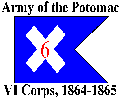 After 1864, the VI
Corps symbol was the Cross of Saint Andrew. Prior to this it
had been the saltier cross.
After 1864, the VI
Corps symbol was the Cross of Saint Andrew. Prior to this it
had been the saltier cross.
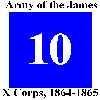 The Army of the James'
X Corps fought in Virginia and North Carolina, under this
simple, but effective corps headquarters flag.
The Army of the James'
X Corps fought in Virginia and North Carolina, under this
simple, but effective corps headquarters flag.
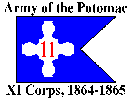 The often ill-fated
XI Corps of the Army of the Potomac used the I Corps flag design
with the number 11 in the center.
The often ill-fated
XI Corps of the Army of the Potomac used the I Corps flag design
with the number 11 in the center.
 The XVIII Corps of
the Army of the James fought under this flag, similar to the X
Corps.
The XVIII Corps of
the Army of the James fought under this flag, similar to the X
Corps.
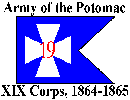 One of the new corps
of the Army of the Potomac, the XIX Corps used this flag
One of the new corps
of the Army of the Potomac, the XIX Corps used this flag
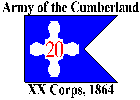 The XX Corps flew
this flag during the last year of the war, including their
capture of Atlanta, and the March to the Sea.
The XX Corps flew
this flag during the last year of the war, including their
capture of Atlanta, and the March to the Sea.
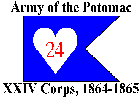 Another of the new
corps of the Army of the Potomac, the XXIV Corps used this flag
which featured a heart, their corps symbol.
Another of the new
corps of the Army of the Potomac, the XXIV Corps used this flag
which featured a heart, their corps symbol.
 The XXV flew this
flag which featured their corps symbol, the square.
The XXV flew this
flag which featured their corps symbol, the square.
 Sometime after taking
command of the Union Army, General Grant adopted this flag to
mark his headquarters, which was in the field with the Army of
the Potomac. A 36 star flag, it has a slightly unusual
arrangement for the stars.
Sometime after taking
command of the Union Army, General Grant adopted this flag to
mark his headquarters, which was in the field with the Army of
the Potomac. A 36 star flag, it has a slightly unusual
arrangement for the stars.
 The Union hero of
Gettysburg, Joshua Chamberlain enjoyed a meteoric rise through
the command structure after his heroic actions on Little Round
Top. After taking command of a brigade in V Corps, he adopted
this banner to mark his location on the battle field.
The Union hero of
Gettysburg, Joshua Chamberlain enjoyed a meteoric rise through
the command structure after his heroic actions on Little Round
Top. After taking command of a brigade in V Corps, he adopted
this banner to mark his location on the battle field.
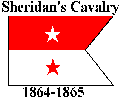 One of the more
flamboyant generals in Union service, the hot-tempered Phil
Sheridan used this banner after taking command of the Cavalry
Corps of the Army of the Potomac.
One of the more
flamboyant generals in Union service, the hot-tempered Phil
Sheridan used this banner after taking command of the Cavalry
Corps of the Army of the Potomac.
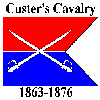 Edging Sheridan inthe flamboyant department, 23-year old General George Custer
designed this fancy flag for his personal banner. He was still
using it in 1876 at the Little Bighorn when he uttered his
famous last words, "Hey, where did all these Indians come from?"
(artistic license used liberally)
Edging Sheridan inthe flamboyant department, 23-year old General George Custer
designed this fancy flag for his personal banner. He was still
using it in 1876 at the Little Bighorn when he uttered his
famous last words, "Hey, where did all these Indians come from?"
(artistic license used liberally)
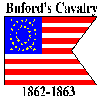 Another of the Union's
heroes at Gettysburg, General John Buford was flying a standard
U.S. Cavalry guidon as his personal banner when he made his
heroic stand north of Gettysburg which bought the Union Army
enough time to seize the vital high ground south of town.
Another of the Union's
heroes at Gettysburg, General John Buford was flying a standard
U.S. Cavalry guidon as his personal banner when he made his
heroic stand north of Gettysburg which bought the Union Army
enough time to seize the vital high ground south of town.


